The barque South Australian was integral to initial colonisation efforts in South Australia, as well as the colony’s early economic development. After serving in British waters in both merchant and military capacities, the vessel was purchased by the South Australian Company and converted for the purpose of transporting goods and people to the fledgling colonial outpost at Kingscote on Kangaroo Island. After serving the new colonial enterprise for just over a year, South Australian was wrecked at Encounter Bay (near present-day Victor Harbour) in December 1837. The vessel’s loss was significant not only because it was South Australia’s first documented shipwreck, but also because it directly affected a number of individuals who played prominent roles in the foundation and development of both the new colony and its capital city.
Early Years
South Australian’s life began as the Falmouth packet Marquis of Salisbury. It was built at Little Falmouth (Flushing), United Kingdom by shipbuilder Richard Symons. Falmouth packets were small vessels specifically designed to transport mail, passengers and freight within Europe’s near-shore and inland waters. The Royal Packet Service, which operated out of Falmouth between 1689 and 1850, also frequently engaged packet ships to transport mail to colonies throughout Great Britain’s expanding overseas empire. Marquis of Salisbury’s keel was laid down in 1817, and the vessel was ready for service two years later. As completed, it had a displacement of 236 tons, an overall length of 87 feet (26.5 metres), and a beam and draught measuring 25 feet (7.6 metres) and 6 feet (1.8 metres), respectively. Its rig is not stated, but was very likely a brig, as this was the most common rigging configuration for Falmouth packets. Sources disagree as to the identity of Marquis of Salisbury’s first owner, but it appears Symons built the vessel for either a Captain Baldock or a Captain Sutton.
Royal Navy Service
In July 1824, Marquis of Salisbury was purchased by the Royal Navy, converted into a 10-gun brig-sloop, and renamed HMS Swallow. Brig-sloops were a special category of two-masted warship that were utilised by the Royal Navy during the first half of the nineteenth century as a more economical alternative to frigates. On account of their smaller size, they were cheaper to build, and required far less crew to operate. When armed with carronades, they also had the highest ratio of firepower-to-tonnage of any vessel in the Royal Navy’s fleet. Swallow entered service in September 1824 under the charge of Lieutenant Commander Thomas Baldock, RN, resumed its role as a packet—this time in the exclusive employ of the military—and continued to operate out of Falmouth. Baldock commanded Swallow until November 1831, when he was replaced by Lieutenant Smyth Griffith, RN. In September 1836, Swallow was sold to the South Australian Company, which registered the vessel as South Australian in London one month later.
South Australian Company Service
By December 1836, South Australian was re-rigged as a barque, and its hull adapted to its new role as a colonisation vessel. It departed Plymouth on 22 December under the command of Alexander Allan, Jr., and stopped in the South Atlantic island archipelago of Tristan de Cunha and the Cape of Good Hope, South Africa before arriving at Kingscote on 22 April 1837. Aboard was a contingent of primarily British and German emigrants, including David McLaren (who would act as the South Australian Company’s second colonial manager), John and Samuel Germein (alternately credited as the discoverer(s) of Port Germein), and ship surgeon Dr. William H. Leigh (who would later author an account of his time in South Australia entitled Reconnoitring Voyages and Travels, with Adventures in the New Colonies of South Australia, &c.). Those travelling aboard South Australian were predominantly skilled labourers, and included among their ranks ‘five fishermen, four shipwrights, a butcher and salter, a smith and farrier…two German vine-dressers [and] a flax-grower’. The vessel also carried breeding stock for the new colony, including two Devon bulls, two Devon heifers, twenty pigs, and twenty Cashmere goats.
Following its arrival at Kingscote, South Australian undertook three voyages to transport provisions, supplies, cargo, personnel, and the occasional passenger between Kangaroo Island and the shore-based whaling station at Encounter Bay. The colony of South Australia was founded on commercial expectation and the enterprising activities of its population of free settlers. As the driving force behind the colony, the South Australian Company engaged in a variety of initiatives that exploited natural resources. Of particular interest to the company were pelagic and shore-based whaling. As part of this enterprise, a shore-based station was established at Rosetta Harbour (on the western end of Encounter Bay) in February 1837. The Encounter Bay facility’s remote location necessitated that it be resupplied by sea, and it was for this purpose that South Australian embarked from the South Australian Company’s headquarters at Nepean Bay in May 1837. Aboard the vessel was a cargo of whaling equipment and provisions for the station’s crew.
Shooting Incident and Loss
South Australian arrived at Rosetta Harbour as the whaling season commenced, and its cargo was quickly offloaded. However, rather than return to Kangaroo Island, Captain Allan was ordered to remain at the whaling station and re-fit his ship as an offshore whale oil processing platform, or ‘cutting-in’ vessel. Rosetta Harbour’s shoreline is rocky, and characterised by large expanses of exposed reef at low tide. These attributes made it nearly impossible for whale carcasses to be dragged ashore and processed for their oil, thereby necessitating the use of South Australian for that purpose instead. Yet another of Rosetta Harbour’s natural features proved its fatal flaw as a whaling station: its anchorage was—and still is—frequently buffeted by westerly swells, and completely exposed to southerly and easterly winds during the summer. Further, a reef (known today as Black Reef) is located immediately north of the anchorage and extends in an almost unbroken line between Wright Island and the harbour’s western shoreline. This meant that vessels servicing the whaling station had very little room to manoeuvre in the event they were caught in storms originating from the south, east or west.
While functioning as a cutting-in vessel, South Australian was the scene of one of two shooting incidents that transpired between Encounter Bay whaling station crewmen and employees of the South Australian Company. On 23 June 1837, the overseer of the whaling station, Captain John William Dundas Blenkinsop, and a whaleboat crew rowed out to the South Australian Company cutter William to follow up a rumour that the cutter’s crew was offering refuge to five deserters from the station. Upon going aboard William, Blenkinsop was met by the cutter’s Master, William Wright. After a brief verbal exchange, Wright aimed a pistol at Blenkinsop and pulled the trigger, but the weapon misfired. Blenkinsop then ordered his crew to row to South Australian so that he could discuss what had just transpired with the acting manager of the South Australian Company, Samuel Stephens. After hailing the barque’s crew multiple times and receiving no response, Blenkinsop attempted to go aboard. In doing so, he encountered Stephens, who fired a pistol at the whaleboat’s helmsman, Thomas Mead. The shot missed its intended target, but penetrated the whaleboat’s hull ‘a few inches’ away from Mead’s thigh. Stephens then pulled two more pistols, demanded Blenkinsop and his crew leave South Australian, and threatened to ‘blow [Blenkinsop’s] brains out’ if his order was refused. The whaleboat crew departed, and Blenkinsop ultimately brought charges against Stephens and Wright in South Australia’s fledgling criminal court.
During the latter half of 1837, South Australian returned to Kangaroo Island, but was soon outfitted for another voyage to Encounter Bay. On 23 November 1837, the vessel departed Kingscote on what would be its last voyage. At its helm was a new commander, Captain J.B.T. MacFarlane, who had taken charge following Allan’s death in September. South Australian arrived at Rosetta Harbour a few days later, and the crew immediately began preparing the whaling station’s takings for the season—200 barrels of whale oil and 10 tons of whalebone—for shipment aboard another South Australian Company vessel, the ship Solway. On 8 December 1837, while awaiting Solway’s arrival, the ship was caught in a severe south-easterly gale, parted its mooring lines, and struck Black Reef stern first. Heavy seas ultimately pushed the vessel over the reef and into shallows near shore, but the hull damage it sustained proved fatal, and the hold rapidly filled with water. No injuries or fatalities occurred as a result of the wreck and most of the crew and passengers—including David McLaren, John Hindmarsh, Jr. (son of the colony’s first Governor Sir John Hindmarsh), and South Australia’s first Chief Justice Sir John Jeffcott—were able to save their personal belongings. Captain MacFarlane and his crew spent the next several weeks salvaging South Australian’s rigging, fittings, equipment and cargo, although the deepest part of the hold remained largely inaccessible, and items within it unrecoverable.
Epilogue
Approximately two weeks later, on 21 December, Solway was wrecked at Rosetta Harbour in circumstances almost identical to those that led to the loss of South Australian. Charles Mann, who was aboard Solway at the time, aptly captured the violence wrought on the Rosetta Harbour anchorage by the severe southerly gale:
I was literally awed. From the Bluff to the nearest island [Wright Island], from thence to shore, and again to the Seal Rock and Granite Island, there was one mass of whitened foam. The heavy roll of the sea was so tremendous that it was frequently impossible, from the decks of the [John] Pirie, although lying near the Solway, to see the lower masts of that vessel…I am sure that no one who witnessed the awful scene which I have described would at such a moment been mad enough to have deemed that anchorage a place of safety.
Shortly after South Australian’s loss, Sir John Jeffcott departed Rosetta Harbour in the company of Captain Blenkinsop to join an expedition then exploring the River Murray. On 12 December, one of the expedition’s boats attempted to exit the river for the return voyage to Encounter Bay and overturned as it crossed the sandbar at the river’s mouth. As a result, Jeffcott, Blenkinsop, and two of the boat’s crew drowned. Their bodies were never recovered.


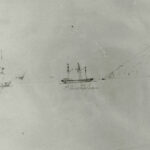

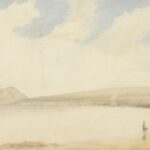
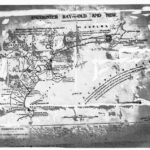
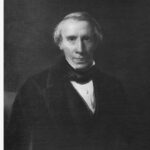
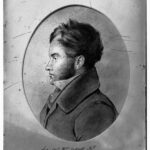
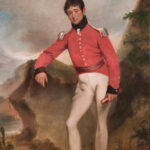
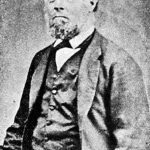
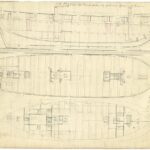

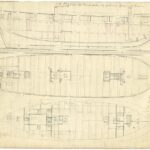
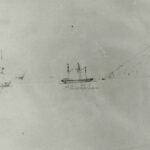
Comments
6 responses to “Barque South Australian”
Are there any drawings or sketches of the barque “Solway” available please
Thanks
I haven’t been able to find any in our catalogue Tim, but I would suggest contacting the South Australian Maritime Museum who might be able to point you in the right direction: https://maritime.history.sa.gov.au/contact/
thank you for this wonderful information on the South Australian. My ancestors arrived on that ship and I put together a rough passenger list many years ago. It may be of interest to others.
The following Passenger list of The South Australian”, was compiled from Pat Buttons book “A Free Passage to Paradise”, from the Pike’s Index and from fellow member of various newsgroups on the internet whose descendants also travelled onboard the ship. I cannot guarantee anything, but I do add that I have never seen ALL of the names except on this particular list.
The passenger number was supposedly 60, but did this include children? I do not know and there is no other list as comprehensive, not even in the Mortlock Library, South Australia.
The South Australian left from Plymouth 22/12/1836 and arrived at Nepean Bay 23/4/1837. First named Marquis of Salisbury the vessel was sold to Royal Navy and became HMS swallow in 1832. In 1836 it was sold to the South Australian Company, registered London, and rigged as a Barque.
Captain J.R.T.McFarlane
60 passengers, as sourced from family genealogists and whatever records I could find. I have found nothing about the crew and wonder if the passengers crewed themselves…
GREGORY FAMILY
1. William – stepfather of Jane
2. Susanna Gregory – mother of Jane,
3. Baby born during the voyage, possibly named William
4. Jane, aged 10, who later wrote her memoirs, which were published by Pioneers Association of SA 1902.
COURTOY (my family)
5. George, a shipwright. Assisted Immigrant, Application no 758, Emb 453.
6. Eliza Sewell, nee Flitt, (daughter of Pattie Thorn and unknown father)
7. Louisa Ann Courtoy, aged about 5
8. George James Courtoy a baby who was buried at Plymouth, UK
DODDRIDGE FAMILY
9. William
10. Thirza, nee Germein, (daughter of John Germein and Christina, nee Easton)
11. John
12. Olinda
13. Samuel
14. Benjamin
15. GERMAIN Benjamin, adult male, Application no 878, Emb. No 460 contact
17. GERMAIN John – application no 886, Emb no 468 John Germain was named by Jane Dobney as the first Head Pilot and the man who Port Germein is named after.
18. GERMAIN Wife C1 adult female
19. GERMAIN Child,
20. GERMAIN Samuel, 1 adult male, Application no 877, Emb. No 459
21. McLAREN Mr. (from E.A.D. Opie’s South Australian Records prior to 1841)
MILDRED FAMILY
22. MILDRED Hon. Henry Richard
23. MILDRED Elizabeth Sarah nee Bowyer, wife of Henry (from E.A.D. Opie’s South Australian Records prior to 1841)
24. MILDRED Clarissa Martha Margaret, daughter
25. MILDRED Urania Harriet, daughter aged 12 – info from K. Ireland, PASA
Report from the South Aust Register Dec 27 1886 p5
“THE PIONEERS
The following passengers of the South Australian are from the official list of all persons provided with a passsage to South Australia wholly, or in part, at their own cost, from the formation of the colony to Dec 31, 1837”
26. PAHLOW Martin,
27. PAHLOW wife
28. PAHLOW child
29. HAYMAN Robert
30. ROWE, James .Buttress,
31. PAHLOW wife
32. PAHLOW Child
29. WRIGHT, Joseph,
33. WATKINS, John,
34. WATKINS wife
35. WATKINS child
from A Free Passage to Paradise (compiled by Pat Button)
33 ALLAN John
34 ANTHONY James H
35 ANTHONY John
36 BUCHAN William
37 CANN John
38 CLARK Alexander
39 CUMMINNS Gregory
40 HODGE William
41 HUGGINS James
42 HUTCHINSON Gilbert
43 INSTER Maxwell
44 LIDDON Ann
45 LIDDON Emma
46 PEARN William
47 PEARN wife
48 PROUT William
49 SHEPHERDSON male
50 WIDGER William
51 WRIGHT Joseph
52 WRIGHT Wife
53 WRIGHT child
54 WYATT John Pearce
55. REHN Johann – From Germany
56. REHN Anna Catarean Elizabeth (nee Schroeter)
57. REHN Sebastian. Son of Johann and Caterean
58. STEIN – From Germany, a labourer for the grape fields
59. SCHULTZ – from Germany, a vine dressers
60. KLEINSCHMIDT from Germany – a Labourer
61. HIFFMAN – from Germany – a labourer
62. AHERNS – From Germany – a labourer
63. Dr. DRESCHER may also have travelled on the ship – he was in charge of the Germans.
Thanks for sharing that Judy, have you seen the Maritime Museum website ‘Passsengers in History’? You can add information to passenger lists there too – http://passengersinhistory.sa.gov.au/
I found this yesterday. I cannot vouch for accuracy and would love to know where he found the names but hopefully it will help others too
FROM: http://graememoad.com/Family/Ships/sthaust.htm
Crew of the South Australian
ANTHONY, John, First Mate
FINDLAY, David, Second Mate
ANTHONY John, Third Mate, brother to captain
ANTHONY, James H, Apprentice
BAILEY, Henry, Apprentice
BUCHAN, William, Able Seaman
CANN, John, carpenter
CLARK, Alexander, Able Seaman and harpooner
HUGGINS, James, Ordinary Seaman
HUTCHINSON, Gilbert, Able Seaman and harpooner
INSTER, Maxwell, Able Seaman and Boatswain
JOHNSTON, John, Able Seaman and harpooner
WIDGER, William, Cook
WYATT, John Pearce, Apprentice
Thanks Judy, it looks like a useful reference. From the numbers included in the table and the reference list below it looks like most of the information on crew came from two sources: (1) Diary of David McLaren (as related by Elise A Ahrens) & (2) Sexton, R.T. Shipping Arrivals and Departures South Australia 1627-1950 Gould Books: Ridgehaven, SA, 1990 (p 34)